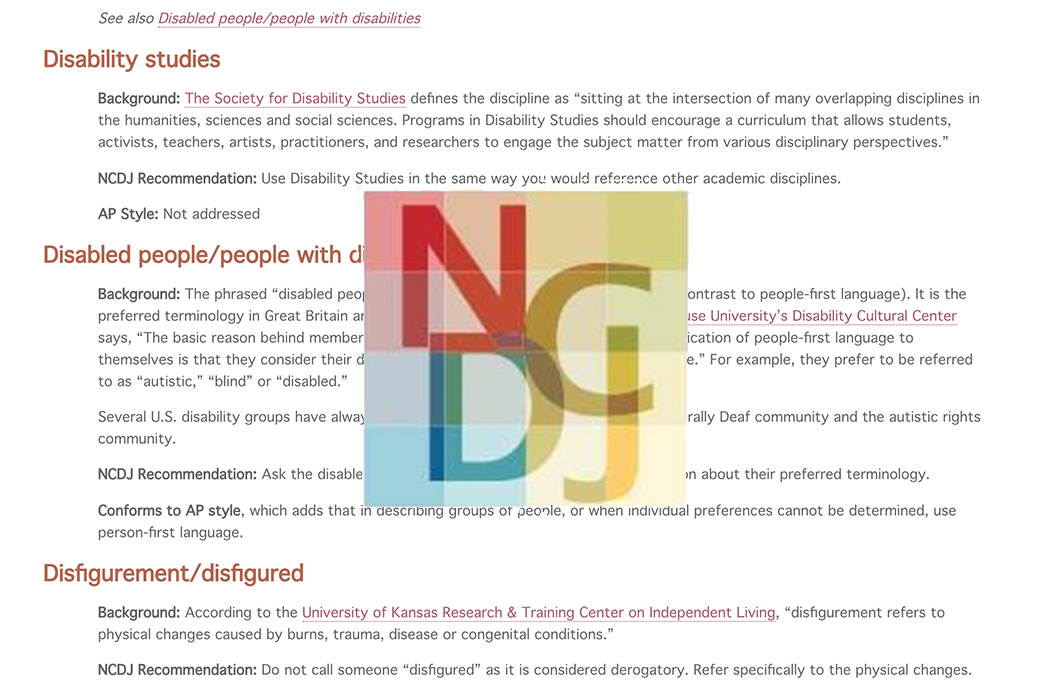In the past, the National Center on Disability and Journalism’s disability language style guide prioritized the use of person-first language — advising language like “person with a disability,” for example.
The document provides guidance to journalists and communications professionals on terms commonly used in relation to those with disabilities or disability issues, covers 100-plus terms and offers a series of baseline recommendations.
In an update announced Sept. 11, the organization’s advice shifted to focus on the source-writer relationship. The guide now acknowledges that identity-first language (“disabled person,” for example) is preferred by many in the disability community.
It’s a change that lead author and longtime journalist Amy Silverman said was an evolution of the previous guide after the NCDJ heard feedback that asked for a move away from a “default.”
“I liked having people-first language to fall back on,” Silverman said, “but I realized that we, as an organization offering language style guidelines, really shouldn’t be doing that because we should be continuing again and again, wherever we can, to emphasize that the most important thing is for the journalists to ask the person with a disability how they’d like to be referred to.”
The previous edition of the guide came in 2018, a time that Silverman called “a miserable summer” because of her fear she would miss a key element as someone who does not identify with disability and whose main connection to the community is through her daughter. This time around, she had more experience and contributors who provided clarifications and suggestions, including the NCDJ’s own advisory board. Silverman said she was thankful for that guidance, especially as those in the disability community and their allies call for more input where disability is discussed.
“I knew this time that I really wanted to run, not everything, but some of the trickier things, past people in the disability community who were experts,” she said, “because the more that I cover this, the more I think about the whole nothing-about-us-without-us movement.”
Also included are comparisons to the AP Stylebook for each entry, examples of when and when not to refer to someone’s diagnosis, and general issues identified within the representation of disability in today’s coverage. Kristin Gilger, the center’s director, told Poynter the AP Stylebook was a key cause for the guide’s existence.
“One of the reasons we really have focused on this guide for a long time now is because the AP Stylebook, as good as it is, has not provided much guidance on language related to disability and so journalists and other communicators are sort of left guessing or being unsure,” Gilger said. “Trying to figure out answers for themselves, which can be confusing because there’s often disagreements about what language choices are appropriate and the language changes quickly.”
Gilger said that the AP referred to the NCDJ’s guide when they were making revisions and that instructors and students in Arizona State University’s programs are heavily encouraged to use it throughout their education, calling it “a staple.” The NCDJ is headquartered at the Walter Cronkite School of Journalism and Mass Communication at ASU.
Instead of positioning the guide as the one true answer to disability in journalism, Gilger pointed to what she sees as the main issue for journalists when it comes to disability reporting: fear.
“We don’t want to be the language police,” she said. “We’re doing this because we want journalists to feel comfortable and to have a resource so that they don’t feel as hesitant, possibly about even doing a story about disability, because they’re afraid they’re going to make a mistake.”
Silverman urged those reading the guide to not consider the guide as a limitation, but to see the connection between writer and subject.
“It’s really, really important that we don’t censor each other, that people don’t think of this language style guide as censorship. Instead, it’s being enlightened, and knowing what your choices are, and knowing why the recommendations are being made,” she said. “Because, again, language says so much about so much more than just words on a page or a screen. And I think you can have humanity and still be a journalist.”
Correction: We spelled Kristin Gilger’s first name incorrectly. We apologize for the error.






